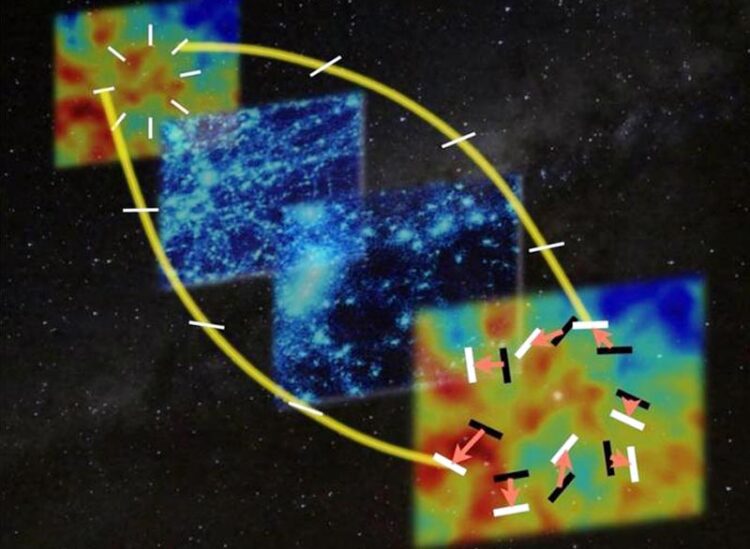Gravitational lensing has significant effect on cosmic birefringence

Cosmic Microwave Background (CMB) polarized light subjected to gravitational lensing effects, in addition to cosmic birefringence. On the far left, the white lines show the polarization pattern of the CMB light generated in the early universe. These rotate due to cosmic birefringence, resulting in the currently observed CMB depicted by the black lines on the right side of the image. However, the path of light is bent by the gravitational distortion of space-time created by the large-scale structure in the middle, and so the white lines showing the polarization pattern on the right side of the image shows what is observed.
Credit: Naokawa and Namikawa, https://doi.org/10.1103/PhysRevD.108.063525
Future missions will be able to find signatures of violating the parity-symmetry in the cosmic microwave background polarization more accurately after a pair of researchers has managed to take into account the gravitational lensing effect, reports a new study in Physical Review D, selected as an Editors’ Suggestion.
How far does the universe extend? When and how did the universe begin? Cosmology has made progress in addressing these questions by providing observational evidence for theoretical models of the universe based on fundamental physics. The Standard Model of Cosmology is widely accepted by researchers today. However, it still cannot explain fundamental questions in cosmology , including dark matter and dark energy.
In 2020, an interesting new phenomenon called cosmic birefringence was reported from the cosmic microwave background (CMB) polarization data. Polarization describes light waves oscillating perpendicularly to the direction it is traveling. In general, the direction of polarization plane remains constant, but can be rotated under special circumstances. A reanalysis of the CMB data showed the polarization plane of the CMB light may have slightly rotated between the time it was emitted in the early universe and today. This phenomenon violates the parity symmetry and is called the cosmic birefringence.
Because cosmic birefringence is challenging to explain with the well-known physical laws, there is a strong possibility that yet to be discovered physics, such as the axionlike particles (ALPs), lies behind it. A discovery of cosmic birefringence could lead the way to revealing the nature of dark matter and dark energy, and so future missions are focused on making more precise observations of the CMB.
To do this, it is important to improve the accuracy of current theoretical calculations, but these calculations so far have not been sufficiently accurate because they do not take gravitational lensing into account.
A new study by a pair of researchers, led by The University of Tokyo Department of Physics and Research Center for Early Universe doctoral student Fumihiro Naokawa, and Center for Data-Driven Discovery and Kavli Institute for the Physics and Mathematics of the Universe (Kavli IPMU) Project Assistant Professor Toshiya Namikawa, established a theoretical calculation of cosmic birefringence that incorporates gravitational lensing effects, and worked on the development of a numerical code for cosmic birefringence that includes gravitational lensing effects, which will be indispensable for future analyses.
First, Naokawa and Namikawa derived an analytical equation describing how the gravitational lensing effect changes the cosmic birefringence signal. Based on the equation, the researchers implemented a new program to an existing code to compute the gravitational lensing correction, and then looked at the difference in signals with and without the gravitational lensing correction.
As a result, the researchers found that if gravitational lensing is ignored, the observed cosmic birefringence signal cannot be fitted well by the theoretical prediction, which would statistically reject the true theory.
In addition, the pair created simulated observational data that will be obtained in future observations to see the effect of gravitational lensing in the search for ALPs. They found that if the gravitational lensing effect is not considered, there would be statistically significant systematic biases in the model parameters of ALPs estimated from the observed data, which would not accurately reflect the ALPs model.
The gravitational lensing correction tool developed in this study is already being used in observational studies today, and Naokawa and Namikawa will continue to use it to analyze data for future missions.
Details of their study were published in Physical Review D on September 27 as an Editors’ Suggestion.
Journal: Physical Review D
DOI: 10.1103/PhysRevD.108.063525
Article Title: Gravitational lensing effect on cosmic birefringence
Article Publication Date: 27-Sep-2023
Media Contact
Motoko Kakubayashi
Kavli Institute for the Physics and Mathematics of the Universe
motoko.kakubayashi@ipmu.jp
Office: 0081-471-365-980
Original Source
Media Contact
All latest news from the category: Physics and Astronomy
This area deals with the fundamental laws and building blocks of nature and how they interact, the properties and the behavior of matter, and research into space and time and their structures.
innovations-report provides in-depth reports and articles on subjects such as astrophysics, laser technologies, nuclear, quantum, particle and solid-state physics, nanotechnologies, planetary research and findings (Mars, Venus) and developments related to the Hubble Telescope.
Newest articles

Innovative 3D printed scaffolds offer new hope for bone healing
Researchers at the Institute for Bioengineering of Catalonia have developed novel 3D printed PLA-CaP scaffolds that promote blood vessel formation, ensuring better healing and regeneration of bone tissue. Bone is…

The surprising role of gut infection in Alzheimer’s disease
ASU- and Banner Alzheimer’s Institute-led study implicates link between a common virus and the disease, which travels from the gut to the brain and may be a target for antiviral…

Molecular gardening: New enzymes discovered for protein modification pruning
How deubiquitinases USP53 and USP54 cleave long polyubiquitin chains and how the former is linked to liver disease in children. Deubiquitinases (DUBs) are enzymes used by cells to trim protein…


